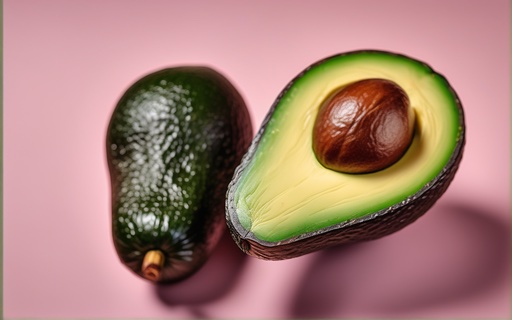Internet Asks: "Pink Avocado"
Avocados, known for their creamy texture and health benefits, occasionally exhibit unusual pink spots in their flesh. This phenomenon, while not widely discussed, can cause concern among consumers. This article aims to shed light on what these pink spots are, why they occur, and if they impact the safety and quality of the avocado.
sponsored links

What Causes Pink Spots in Avocado Flesh?
The appearance of pink spots in avocado flesh is typically uncommon and can be attributed to several factors:
-
- Oxidation: Similar to how an apple browns when exposed to air, avocados can undergo oxidation. When the flesh of an avocado is exposed to oxygen, it can sometimes develop pinkish or reddish spots. This is a natural reaction and doesn't necessarily indicate spoilage.
-
- Varietal Differences: Certain avocado varieties are more prone to developing such discolorations. Some types have flesh that naturally oxidizes to a pink hue.
-
- Temperature Changes: Fluctuations in temperature during storage or transport can cause avocados to ripen unevenly, potentially leading to discoloration.
- - Disease or Fungal Infection: While less common, certain bacterial or fungal infections can cause discoloration in the flesh of avocados.
-
- Internal Bruising: Physical damage, either from handling or transportation, can lead to bruising of the flesh, which might appear as pink or red spots.
- - Chemical Reactions: Chemical reactions between avocado compounds and kitchen utensils, particularly those made of iron or copper, can also result in pink discoloration.
Are Pink Spots on Avocado Safe to Eat?
In many cases, avocados with pink spots are safe to eat, especially if the discoloration is due to natural ripening or mild oxidation. However, it is crucial to assess the overall quality of the fruit:
- - Texture: If the avocado is firm and the rest of the flesh looks and smells normal, it is likely safe to eat.
- - Smell and Taste: A sour or unpleasant odor is a clear indicator that the avocado has gone bad.
- - Visual Inspection: Look for other signs of spoilage, such as mold or excessively brown and mushy areas.
How to Prevent Pink Spots
While it's not always possible to prevent this discoloration, proper storage and handling can reduce the likelihood:
- - Gentle Handling: Avoid squeezing avocados too hard, and store them in a place where they won't be crushed or bumped.
- - Proper Storage: Keep unripe avocados at room temperature and ripe avocados in the refrigerator. If you've cut the avocado, store the unused portion in an airtight container with a pit in the fridge.
- - Timely Consumption: Eat avocados when they're just ripe to avoid overripening issues.
Conclusion
Pink spots in avocado flesh can occur due to various reasons, from natural ripening processes to potential spoilage. Understanding these causes can help you make an informed decision about whether to consume the avocado. Generally, if the fruit shows no signs of spoilage and smells normal, it's safe to eat after removing the discolored areas. However, always prioritize safety and discard any fruit that looks or smells off.
Disclaimer: This article provides general information and should not be taken as professional advice. If you're unsure about the safety of an avocado or if it shows signs of significant spoilage, it's best to err on the side of caution and not consume it. For specific concerns, consult a food safety expert or a related professional.
sponsored links
References
1. USDA Food Data Central. "Avocados, raw, all commercial varieties." https://fdc.nal.usda.gov/fdc-app.html#/food-details/171705/nutrients.
2. California Avocado Commission. https://californiaavocado.com/
3. University of California Agriculture & Natural Resources. "Red Discoloration in My Avocado Flesh." https://ucanr.edu/blogs/blogcore/postdetail.cfm?postnum=25157#:~:text=%22You%20occasionally%20see%20this%20problem,flesh%20which%20is%20surface%20only.%22
4. Hass Avocado Board. Common Fruit Defects. https://hassavocadoboard.com/wp-content/uploads/Hass-Avocado-Board-07-Common-Fruit-Defects.pdf
5. FoodSafety.gov. "Safe Handling of Fruits and Vegetables." https://www.foodsafety.gov/food-safety-charts/safe-handling-fruits-and-vegetables
6. American Society for Horticultural Science. "Handling and Storage Effects on a Retail Display Quality of Avocado Fruit." https://journals.ashs.org/hortsci/view/journals/hortsci/hortsci-overview.xml
7. Smith, N. J., & Margolies, D. (2018). Chemistry in the Kitchen. Journal of Culinary Science.
People are also reading...
Calories in Small Avocado
Calories Small Avocado
1 Small Avocado Calories
Avocado Toast Dunkin
Avocado Bacon Burger
Matcha Drinks at Starbucks
Matcha Green Tea Latte Starbucks Calories
See the answer to: "Matcha Green Tea Latte Starbucks Calories"
Starbucks Matcha Ingredients
Matcha Starbucks Drinks
Calories In Steak?
Chicken Taco Calories?
Does Hot Chocolate Have Caffeine?
Are Mangoes Acidic?
Orange Juice pH?
Calories In a Grilled Cheese?
Ready to level-up?
Create meal plans 10x faster, follow up with your clients through our mobile app, and never struggle with meal planning or recipe management again.